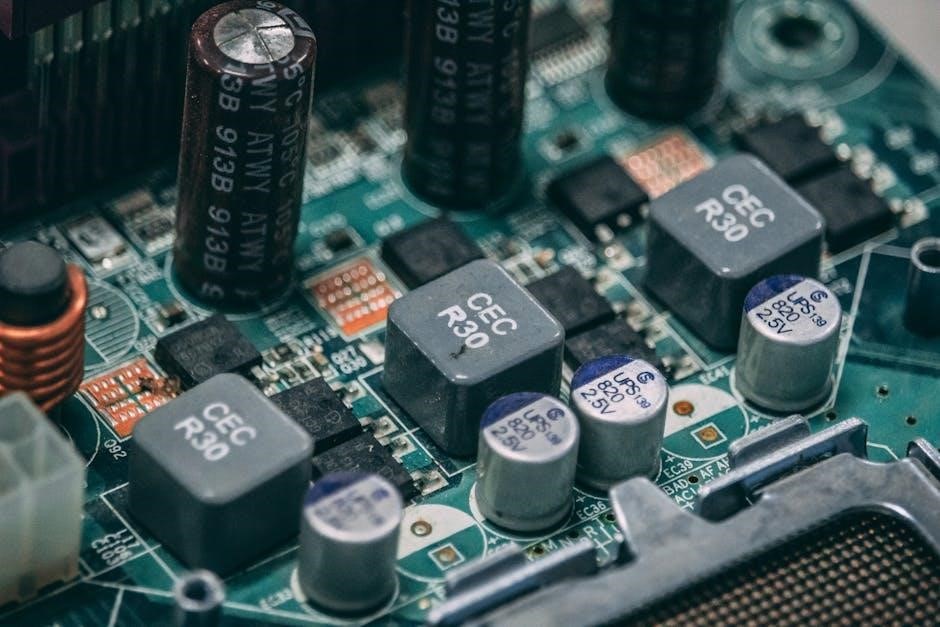suzuki battery isolator lead voltage output pdf
The Suzuki battery isolator lead is a critical component in marine electrical systems, ensuring the auxiliary battery is charged by the alternator while protecting the starting battery․
1․1 Overview of Suzuki Battery Isolator Leads
Suzuki battery isolator leads are specialized wiring components designed to connect the alternator to the auxiliary battery in dual-battery systems․ These leads ensure the house battery is charged by the engines alternator while preventing over-discharge of the starting battery․ They utilize diodes or relays to control current flow, allowing charging only when the engine is running․ Available as optional accessories for specific outboard models, they are identified by unique part numbers like 33830-98J11․ Their design ensures independent operation of both batteries, enhancing system reliability and performance in marine applications․
1․2 Importance of Voltage Output in Dual Battery Systems
Voltage output is crucial for proper charging in dual-battery systems․ The alternator produces a specific voltage range (13․5V to 14․5V), essential for charging both starting and auxiliary batteries․ The isolator ensures this voltage is transferred efficiently without overcharging or undercharging․ Proper voltage output maintains battery health and ensures reliable power for engine ignition and onboard accessories․ Inconsistent voltage can lead to battery damage or system failure, making accurate regulation vital for optimal performance and longevity of the electrical system․

Voltage Output Specifications of Suzuki Battery Isolator Leads
The Suzuki battery isolator lead operates within a standard voltage range of 13․5V to 14․5V, ensuring efficient charging of both the starting and auxiliary batteries without overcharging․
2․1 Typical Voltage Range (13․5V to 14․5V)

The Suzuki battery isolator lead typically operates within a voltage range of 13․5V to 14․5V, ensuring optimal charging of both the starting and auxiliary batteries․ This range is critical for maintaining battery health, as it prevents undercharging and overcharging․ A voltage below 13․5V may result in inadequate charging, while exceeding 14․5V could damage the batteries or electrical components․ Monitoring this range is essential for system performance and longevity, ensuring reliable power delivery in marine applications․
2․2 Factors Influencing Voltage Output
Several factors influence the voltage output of a Suzuki battery isolator lead, including the alternator’s efficiency, battery condition, and wiring integrity․ The alternator’s output voltage directly affects the isolator lead’s performance․ Additionally, the health and state of charge of the starting and auxiliary batteries can impact voltage regulation․ Corrosion or damage to the wiring and connections may also reduce voltage output․ Environmental factors, such as temperature and moisture, can further influence the system’s overall efficiency and reliability․
2․3 Role of the Isolator in Voltage Regulation
The Suzuki battery isolator plays a crucial role in voltage regulation, ensuring stable power distribution to the auxiliary battery․ By incorporating advanced circuitry, it prevents overcharging and maintains optimal voltage levels between 13․5V and 14․5V․ This ensures efficient charging of both the starting and auxiliary batteries without risking damage․ The isolator’s design protects against voltage spikes and drops, safeguarding the electrical system’s integrity and reliability during engine operation and battery charging cycles․

Locating the Battery Isolator Lead Connector
The battery isolator lead connector varies in location across Suzuki models, often near the alternator or wiring harness․ It’s typically a multi-pin connector with color-coded markings for easy identification․ Consulting the owner’s manual or online forums can provide model-specific guidance, ensuring accurate location and proper system functioning․ This step is crucial for troubleshooting and maintaining the dual-battery system effectively․
3․1 Connector Location Variations Across Models
The location of the battery isolator lead connector varies across different Suzuki models․ In some models, it is found near the alternator, while in others, it is situated closer to the engine’s wiring harness․ This variability necessitates consulting the specific model’s manual or wiring diagram for precise location identification․ Additionally, online forums and communities often provide insights from experienced users, helping to pinpoint the connector’s position accurately․ This step is essential for effective troubleshooting and system maintenance․
3․2 Identifying the Connector and Its Markings
Identifying the battery isolator lead connector involves recognizing its distinct features․ It is typically a multi-pin connector, often enclosed in a protective housing for durability․ Color coding on the wires and markings on the connector help differentiate it from other components․ Consulting the Suzuki service manual or wiring diagram is essential for accurate identification․ Additionally, online forums and resources provide detailed descriptions and images, aiding in pinpointing the connector’s identity and ensuring proper troubleshooting and maintenance procedures․
Troubleshooting Common Issues with Suzuki Battery Isolator Leads
Common issues include voltage drops, low output, and high voltage․ Check connections for corrosion or looseness and ensure proper fuse function․ Replace faulty components promptly to maintain system reliability․
4․1 Diagnosing Voltage Drops and Low Output
Diagnosing voltage drops and low output in Suzuki battery isolator leads involves checking the starting battery’s voltage with the engine off (should be ~12;6V)․ With the engine running, measure the auxiliary battery’s voltage (should be 13․5-14․5V)․ Inspect connections for corrosion or looseness and ensure the isolator lead fuse is intact․ If voltage remains low, the isolator lead may be faulty, requiring replacement․ Regular maintenance helps prevent these issues, ensuring reliable dual-battery system performance;
4․2 Addressing Low Voltage Output Scenarios
Addressing low voltage output in Suzuki isolator leads starts with checking connections for cleanliness and tightness․ Ensure the battery switch is correctly positioned to allow charging․ If issues persist, inspect the isolator lead for damage or corrosion and replace if necessary․ Using a voltmeter to monitor real-time voltage helps identify malfunctions․ Regularly inspecting the wiring and connections prevents voltage drops, ensuring the auxiliary battery charges efficiently and maintains system reliability․ Prompt action prevents deeper discharge and potential system failure․

4․3 Managing High Voltage Output and Overcharging
Excessive voltage output can damage batteries and electrical components․ Monitor voltage levels using a voltmeter to ensure they remain within the 13․5V to 14․5V range․ If overcharging occurs, inspect the isolator lead for faults or internal damage․ Ensure all connections are secure and free from corrosion․ Adjusting the alternator settings or installing a voltage regulator can help prevent overcharging․ Regular checks prevent damage to the auxiliary battery and maintain system stability, ensuring long-term reliability and performance․ Always refer to Suzuki specifications for guidance․
The Role of the Battery Isolator in Dual Battery Systems
The battery isolator in dual systems separates the starting and auxiliary batteries, ensuring efficient charging of both without cross-drain, maintaining system reliability and performance․
5․1 Separating Starting and Auxiliary Batteries
The Suzuki battery isolator ensures the starting and auxiliary batteries operate independently․ It prevents the auxiliary battery from draining the starting battery when the engine is off․ Using diodes or relays, the isolator allows the alternator to charge both batteries while maintaining separation․ This design safeguards the starting battery, ensuring reliable engine ignition, and protects the auxiliary battery from deep discharge․ The isolator’s role is crucial for maintaining dual battery system reliability and performance in marine applications․

5․2 Ensuring Independent Charging and Discharging
The Suzuki isolator ensures independent charging and discharging of the starting and auxiliary batteries․ When the engine runs, the alternator charges both batteries via the isolator․ The isolator prevents the auxiliary battery from draining the starting battery when the engine is off․ This separation allows each battery to serve its purpose without interference, ensuring reliable engine ignition and auxiliary power․ The isolator also protects against overcharge and deep discharge, maintaining system balance and performance in marine applications․

Installation and Wiring of Suzuki Battery Isolator Leads
Installing Suzuki battery isolator leads involves connecting the alternator to the auxiliary battery using high-capacity cables, ensuring proper power distribution and system safety․ Always consult the manual․
6․1 Step-by-Step Wiring Guide
Connect the isolator lead to the alternator’s output terminal․
Attach the other end to the auxiliary battery’s positive terminal․
Secure the ignition wire to the isolator’s input side․
Ensure all connections are tight and protected․
Use 30-50Amp cables for reliability․
Consult the Suzuki manual for specific wiring diagrams․
Test the system to confirm proper voltage output․
Regularly inspect connections for corrosion or damage․
6․2 Best Practices for Secure Connections
Use 30-50Amp cables for the isolator lead to ensure reliable power transfer․
Avoid overloading the circuit to prevent voltage drops․
Protect connections from moisture and corrosion using waterproof seals․
Secure the isolator lead away from heat sources and moving parts․
Regularly inspect connections for tightness and damage․
Use heat-resistant materials for connections near the alternator․
Follow the Suzuki manual for specific wiring recommendations․
Test the system after installation to ensure proper voltage output․

Monitoring and Maintaining the System
Regularly monitor the system using a voltmeter to check voltage levels and inspect connections for corrosion or damage․ Ensure all connections are tight and protected from moisture to maintain optimal performance and prevent electrical issues․
7․1 Using a Voltmeter for Voltage Checks
Using a voltmeter is essential for monitoring the voltage output of the Suzuki battery isolator lead․ Connect the voltmeter to the battery terminals to measure the voltage․ A healthy system should display a reading between 13․5V and 14․5V when the engine is running, indicating proper charging․
If the voltage is low, inspect the connections for corrosion or damage․ A reading below this range may suggest issues with the isolator lead or alternator․ Regular checks ensure the system functions efficiently and prevents electrical failures․
7․2 Regular Inspection of Connections and Components
Regular inspection of the Suzuki battery isolator lead connections and components is vital for maintaining system reliability․ Check for corrosion, loose connections, and damage to wires or terminals․ Clean any corrosion using a wire brush and apply a protective coating to prevent rust․ Ensure all connectors are securely fastened and free from wear․ Inspect the isolator lead’s protective housing for signs of damage or moisture ingress․ Addressing these issues promptly helps prevent electrical failures and ensures consistent voltage output to the auxiliary battery․
8․1 Summary of Key Points
The Suzuki battery isolator lead is essential for dual battery systems, ensuring proper voltage output and protecting the starting battery․ It acts as a bridge between the alternator and auxiliary battery, enabling efficient charging while preventing over-discharge․ The isolator lead maintains a consistent voltage range of 13․5V to 14․5V, crucial for optimal charging․ Regular inspections and maintenance are vital to prevent issues like corrosion and loose connections, ensuring reliable performance in marine electrical systems․
8․2 Final Thoughts on Importance and Maintenance
The Suzuki battery isolator lead is a vital component for reliable dual battery systems, ensuring proper voltage output and protecting the starting battery․ Regular maintenance, including checking connections for corrosion and monitoring voltage levels, is essential to prevent issues․ Proper wiring and adherence to voltage specifications (13․5V to 14․5V) are critical for optimal performance․ By prioritizing maintenance, users can ensure a durable and efficient electrical system, avoiding potential failures and extending the lifespan of both batteries and related components․